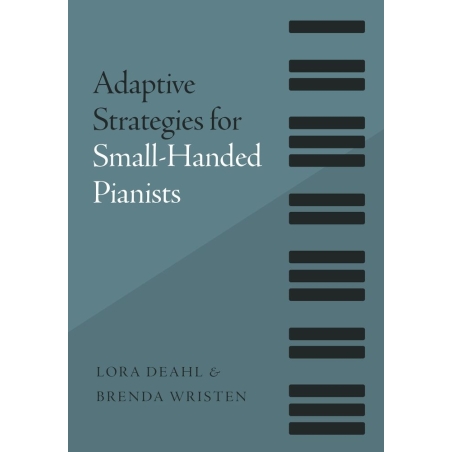This comprehensive study offers practical strategies for overcoming the unique challenges of practicing and performing as a small-handed pianist. Informed by established scientific and pedagogical principles and illustrated by hundreds of examples, it is an incomparable resource for pianists and teachers.
CONTENTS
Foreword
Acknowledgments
Key to Abbreviations and Graphic Symbols
Chapter 1: Understanding Small-Handedness
Defining the Small Hand
1 Demographics of Small-Handedness
1 The Evolution of the Modern Piano and Its Relationship to Small-Handedness
2 Historical Background
2 Ergonomically-Scaled (Reduced-Size) Piano Keyboards
1 Pedagogical Misconceptions About Small Hands
2 Selection Bias and Other Gender-Related Aspects
2 Attempts to Stretch the Small Hand
1 Small-Handedness and Injury
1 The Role of the Teacher
1 Conclusion
1 Reflection Points
Chapter 2: Fundamental Principles of Movement and the Playing Apparatus
1 Principles of Work Efficiency
1 Principles of Movement
2 Leverage
2 Newton's Laws and Piano Technique
2 Muscular Contraction and Release
2 Additional Characteristics of Movement Economy
2 Planes of Motion
2 Neutral Position at the Piano
1 The Parts of the Playing Apparatus
2 Torso
2 Shoulder and Upper Arm
2 Forearm
2 Wrist
2 Hand and Fingers
1 Conclusion
1 Reflection Points
Chapter 3: Technique and the Small-Handed Pianist
1 Maladaptive Tendencies
2 Fatigue
2 Power
2 Reach
1 Lexicon of Fundamental Facilitative Techniques for the Small-Handed Pianist
2 Avoiding Fatigue
3 Timing Muscular Releases
3 Using Levers Appropriately
3 Cultivating Finger-To-Elbow Alignment
3 Combining Basic Movements into Larger Gestures
3 Reducing the Amplitude of Movements and Gestures
2 Producing Power
3 Maximizing Key Speed
3 Transmitting Force Through Skeletal Structures
3 Using Arm Impulses
2 Addressing Large Reaches and Distances
3 Using the Arm to Navigate Distances
3 Using Passive Spread
3 Using Vertical Spanning
1 Boundaries
1 Conclusion
1 Reflection Points
Chapter 4: Redistribution
1 Uncrossing Parts
1 Eliminating Stretches in Chords and Arpeggios
1 Facilitating Leaps or Hand Shifts
1 Increasing Accuracy, Power, and Control
1 Maintaining More Neutral Hand and Wrist Positions
1 Facilitating Trills and Tremolos
1 Maintaining Legato and Line
1 Projecting Harmony
1 Conclusion
1 Application Problems
Chapter 5: Refingering
1 Fingering and Hand Size
1 Encouraging Compact Hand Positions
2 Chords
2 Arpeggios, Broken Chords, and Melodic Intervals
2 Consecutive Double Notes and Octaves
2 Readjusting the Hand to a More Compact Shape
2 Playing Seconds with the Thumb Alone
2 Using Non-Consecutive Fingerings
2 Playing Trills
1 Repeating the Same Finger to Recover Space in the Hand
1 Optimizing Sound Production and Voicing
2 Repeated Use of the Fifth Finger and Thumb to Project Melodies
2 Aligning the Hand and Forearm in a Skeletal Position
1 Moving Longer Fingers over Shorter Fingers
1 Substituting the Thumb for Inner Fingers
1 Using Positional Fingerings to Achieve Maximum Speed
1 Substituting One Finger for Another on the Same Key
1 Retaking Released Notes Silently
1 Conclusion
1 Application Problems
Chapter 6: Maximizing Reach and Power
1 Covering Large Distances
2 Applications of Either Oval or Fan-Shaped Gestures
2 Applications of Oval Gestures
2 Applications of Fan-Shaped Gestures
1 Facilitating Large Reaches
2 Applications of Passive Spread
2 Applications of Vertical Spanning
2 Applications of Passive Spread in Conjunction with Vertical Spanning
1 Dividing or Rolling Chords
2 Consecutive and Non-Consecutive Divisions or Rolls
2 Simultaneous Divisions or Rolls
1 Releasing Notes
2 Releasing Notes in Chords and Multi-layered Textures
2 Releasing Notes in Melodic Intervals, Arpeggios, and Broken Chords
2 Releasing Notes in Broken Octaves
1 Using Rotation for Power
1 Taking Advantage of Skeletal Support
1 Playing Staccato Chords and Octaves
2 Repeated Chords and Octaves
2 Traveling Staccato Chords and Octaves
2 Legato Octaves
1 Grouping Notes into Larger Gestures
1 Omitting and Revising Notes
1 Conclusion
1 Application Problems
Chapter 7: Musical Solutions for Technical Problems
1 Legato
2 Legato in Widespread Cantabile Melodies and Arpeggiated Accompaniments
2 Legato in Octave and Double-Note Passages
1 Fortissimo Playing
1 Pedaling
2 Damper Pedal
2 Sostenuto Pedal
1 Voicing
1 Rhythmic Inflection, Tempo Modification, and Rubato
1 Gestural Shaping
1 Conclusion
1 Reflection Points
Chapter 8: Integration and Exploration
1 Diagnosis and Integration
1 Exploration
1 Closing Thoughts
Glossary of Terms
Bibliography
List of Activities
List of Examples
Lists of Figures
List of Tables
Index




